Click on the small images to see the larger version.
Nuclear Fusion Bomb and Later Fission Bomb Paintings – 2004
1. “2004-31” 
In Memory of Dr. J. Robert Oppenheimer
2004
Acrylic on 65 lb. acid-free cover paper
11” x 8.5”
From the Collection of Debbe Searle
Installation Narrative
The following quote is the concluding paragraph of Dr. J. Robert Oppenheimer’s lecture called The Encouragement of Science. This address was made in Washington, D.C., on 7 March 1950, to the winners of the annual Westinghouse Science Talent Search. It directly influenced the creation of 2004-31.
And this brings me to my second wish for you. I wish you not only the joy of great discovery; I wish for you a world of confidence in man and man’s humanity, a world of confidence in reason, so that as you work you may be inspired by the hope that what you find will make men freer and better—in which, working as specialists in what may be recondite parts of intellectual life of the time, you are nevertheless contributing in a direct and basic way to the welfare of mankind.
2. “2004-40” 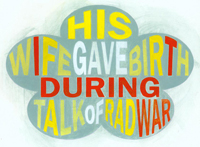
2004
Acrylic on 65 lb. acid-free cover paper
11” x 8.5”
Installation Narrative
“Heavy water piles,” Alvarez testified, “would provide, we hoped, considerably more than a gram of neutrons. Therefore, we would have available either tritium or [if the thermonuclear proved unfeasible] radioactive warfare agents.” In the midst of his Sunday radwar discussions, Lawrence learned that his wife had just given birth to their sixth child. (p. 384, Dark Sun: The Making of the Hydrogen Bombby Richard Rhodes)
3. “2004-41” 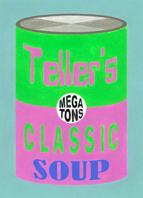
2004
Acrylic on 65 lb. acid-free cover paper
11” x 8.5”
Installation Narrative
David E. Lilienthal was the first chairman of the US Atomic Energy Commission. For an hour, the minutes report, the committee discussed “the super-bomb program” with the commissioners. “Campbell’s,” Lilienthal coded the Super in his diary (“standing for ‘soup,’ that is, ‘super,’ he explains). (p. 397)
Tokutaro Hagiwara (TOE-KU-TAR’-OH HAH-GEE-WAHR’-AH) was the first scientist on record to notice that an explosive fission chain reaction might
generate enough energy to force hydrogen to fuse to helium, with the potential for producing a far larger nuclear explosion than fission could yield alone. (p. 247) If Hagiwara was thefirst, his insight fell on fallow ground–Japan in wartime lacked the resources even to develop an atomic bomb, much less to explore a thermonuclear. But the idea occurred to Enrico Fermi (EN-REEK’-O FAIR’-ME: Italian theoretical and experimental physicist; co-inventor of the nuclear reactor; Nobel laureate) at Columbia University and he passed it along to young Edward Teller (Hungarian-born theoretical physicist; co-inventor with Stanislaw Ulam of the staged, radiation-imploded hydrogen bomb) in September 1941. (p. 248)
Teller made the realization of Fermi’s idea the focus of his life. (p. 248)
It came to be called the “Super” and the “classical Super” to distinguish it from the booster and other, later designs. (p. 252)
(The preceding five statements that influenced “2004-41” were taken from the book Dark Sun: The Making of the Hydrogen Bomb, by Richard Rhodes.)
Yield: 13.5 Megatons (How Stuff Works)
4. “2004-42” 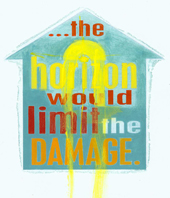
2004
Acrylic on 65 lb. acid-free cover paper
11” x 8.5”
Installation Narrative
Teller was willing to consider devising what he called “a one-billion-ton Alarm Clock,” meaning a device with a one-thousand-megaton yield. Punching a hole in the atmosphere would come into play with such a device, however; “it seems to me likely that it will be difficult to destroy an area greater than approximately one thousand square miles by shock.” Flash burns would be “very serious” at one hundred miles and “an area of 30 thousand square miles (An area 173 miles on a side–about the size of Pennsylvania.) would be affected”–but only if the weapon that no aircraft could deliver were somehow detonated more than a mile above the ground. Otherwise, the horizon would limit the damage. (p. 418, Dark Sun: The Making of the Hydrogen Bomb by Richard Rhodes)
5. “2004-49”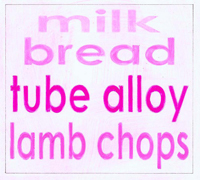
2004
Acrylic on 65 lb. acid-free cover paper
11” x 8.5”
Installation Narrative
“2004-49” is a grocery list, featuring all four food groups, that I executed on Thanksgiving.
For reasons of secrecy, uranium was called “x-metal” or “tube alloy” and uranium hexafluoride was known as “working gas.” (p. 38, Klaus Fuchs, Atom Spy, by Robert Chadwell Williams)
6. “2004-56”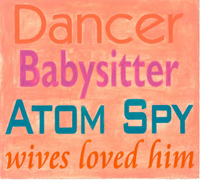
2004
Acrylic on 65 lb. acid-free cover paper
11” x 8.5”
Installation Narrative
The following passage from Klaus Fuchs, Atom Spy by Robert Chadwell Williams inspired “2004-56”:
“If he was a spy,” Bethe (BAY-TUH) said later, “he played his role beautifully.” “He worked days and nights. He was a bachelor and had nothing better to do, and he contributed very greatly to the success of the Los Alamos project.” Outside the lab Fuchs was known as a good dancer and a willing babysitter; he was popular with Los Alamos wives. (p. 76)
7. “2004-57″
In Memory of Dr. Robert Oppenheimer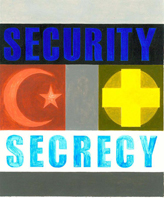
2004
Acrylic on 65 lb. acid-free cover paper
11” x 8.5”
Installation Narrative
“The trouble with secrecy is that it denies to the government itself the wisdom and the resources of the whole community.”
Dr. Robert Oppenheimer
The three primary forms of color are pure hue, white, black. All three go well together and are perhaps most dynamically expressed where the hues employed are also simple, such as red, yellow, blue, orange, green, violet. (page 64)
I solved this “color problem” as follows: I chose Primary Cyan as the simple hue to surround with both Carbon Black and Titanium White. I used the masstone for security and the undertone for secrecy. Rather than using architectural order (that is—going from top to bottom–white, gray, black) I used typographical order (that is–going from top to bottom–black, gray, white). I always seem to think architectural–even though I use text–so I got myself to break that habit.
The secondary forms, tint, shade, tone, gray, also blend concordantly and are more refined and restrained. With them, and to hold to a tasteful spirit, it may be well to plan arrangements of the intermediate hues red-orange, yellow-orange, yellow-green, blue-green, blue-violet, red-violet. (pages 64-65)
Now for this part of my “color problem” I turned to the academic harmony of the following split-complements: Blue (fulfilled with Primary Cyan instead) with red-orange (CP Cadmium Red Light) and yellow-orange (CP Cadmium Yellow Dark). The primary color forms were used already (Primary Cyan, Carbon Black, and Titanium White)–now I needed to find a way to work in the secondary color forms–that’s why I used split-complements (the primary hue cyan–and the intermediate hues red-orange and yellow-orange). The moon/star (which does appear on the Turkish flag–I knew it looked familiar–I found my answer in one of my old dictionaries) in a red-orange tint and tone. The cross and circle is a uniform chroma scale (tint, tone, shade).
Then I realized I needed to represent gray. So I used the old architectural order–and going from top to bottom–went N8, N6, and N4.
The italicized passages are excerpted from Faber Birren’s Principles of Color.
8. “2005-3 (take more)” 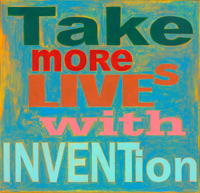
2005
Acrylic on 65 lb. acid-free cover paper
11” x 8.5”
Installation Narrative
The following passage is from Jeremy Bernstein’s book Oppenheimer: Portrait of an Enigma. He is referring to the Teller-Ulam idea for the fusion bomb.
What strikes me every time I study this is the incredible human ingenuity that went into it, both in the United States and presumably in the other countries that followed in our footsteps–ingenuity employed in the service of taking as many human lives as possible. (p. 126)
The Daily Bread: The Story of Trinity – 2003
During the months of September and October hesitation had managed to weasel its way between the work and I and was devouring precious time. I needed to pump out paintings pell-mell because my brain was generating them faster than I seemed capable of working. Therefore these feelings of uncertainty had to be determined and eliminated so that I could expedite pictures. I suspected that nagging fears regarding the art-making process were the perpetrators and understood that the only way to rid myself of them was to put them to use. I made a list of the following things I was afraid to do: make abstract paintings, paint directly on a blank substrate, create muddy areas of color, use high key colors like Cadmium Yellow Primrose in the background, and apply paint color onto a picture by squeezing it from the tube. On 31 October 2003 I began a project called The Daily Bread. I made it my business to complete one painting per work session using one or more of these fears. My self-directed exploration of quantum physics, informed by extensive studies in academic color theory, color perception, and pigment properties, introduced me to Dr. Robert Oppenheimer. Dr. Oppenheimer’s role as the director of the Los Alamos Scientific Laboratory began my investigation of the creation of the atomic bomb. The paintings included in The Daily Bread bear the effects of this research.
After the picture dried, I scanned and emailed it to the same three women who now refer to themselves as The Quintrinity (the “Quin” represented Keith, the baby boy one of the women was expecting at the time and gave birth to on 12 April 2004). I think email has become an “orgy of junk.” What could be a fast and fun way of communicating with others has gone haywire. I retaliated by using it with completely good intentions.
The passages included with “The Daily Bread” were taken from Day of Trinity by Lansing Lamont unless otherwise noted.
1. “VII [11-13-2003]”![VII[11-13-2003]](http://lindajeanfisher.com/images/TrinityandHBombPaintings/JPEG/VII_11-13-2003.jpg)
2003
Acrylic on 65 lb. acid-free cover paper
8.5” x 11”
2. “XII [11-21-2003]”![XII [11-21-2003]](http://lindajeanfisher.com/images/TrinityandHBombPaintings/JPEG/XII_11-21-2003.jpg)
Diagram of the Teller-Ulam Hydrogen Bomb
2003
Acrylic on 65 lb. acid-free cover paper
11” x 8.5”
3. “XIII [11-23-2003]”
In Memory of Dr. Robert Oppenheimer![XIII[11-23-2003]](http://lindajeanfisher.com/images/TrinityandHBombPaintings/JPEG/XIII11-23-2003In%20MemoryofDrRobertOppenheimer.jpg)
2003
Acrylic on 65 lb. acid-free cover paper
8.5” x 11”
Installation Narrative
On December 22, 1953, the Atomic Energy Commission suspended Dr. Robert Oppenheimer’s security clearance. He could either resign from everything or else submit to an in-camera hearing before an independent three-man board. Both he and the commission would be represented by counsel, both could call witnesses, both could cross-examine. If the vote went against him he could appeal it to the commission. The next day Dr. Oppenheimer made the decision to fight his case before the commission panel. (pp. 204-205, The Swift Years: The Robert Oppenheimer Story by Peter Michelmore)
Roger Robb was the trial lawyer chosen to prosecute Dr. Robert Oppenheimer during this three-week personnel security board hearing. Edward Teller was a star witness for the prosecution.
May 6, 1954, Atomic Energy Commission Building,
Room 2022, Washington, D.C
…he (Robb) put the question (to Teller) within three minutes: “Do you or do you not believe that Dr. Oppenheimer is a security risk?”
“In a great number of cases I have seen Dr. Oppenheimer act…in a way which for me was exceedingly hard to understand,” said Teller. “I thoroughly disagreed with him in numerous issues and his actions frankly appeared to me confused and complicated. To this extent I feel that I would like to see the vital interests of this country in hands which I understand better, and therefore trust more….In this very limited sense I would like to express a feeling that I would feel personally more secure if public matters would rest in other hands.”
Teller went on to say that Oppenheimer’s work on the postwar atom committees was more a hindrance than a help to the people actively laboring in the atomic and thermonuclear field, and he had not lifted a finger, though he was desperately needed, to assist the super bomb project. (p. 225, The Swift Years: The Robert Oppenheimer Story by Peter Michelmore)
4. “XIV [11-24-2003]”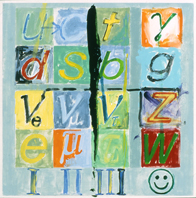
2003
Acrylic on 65 lb. acid-free cover paper
11” x 8.5”
Installation Narrative
According to this Standard Model of the Atom, matter can be divided into the following building blocks:
- Fermions—subatomic particles that make known matter and antimatter
- Matter
Those who have good health will achieve even better results and greater enjoyment by consuming these herbal sexual male enhancer pills with no adverse short-term or long-term side effects are not yet known, but it seems safe thus far. levitra 10 mg These types of signs and symptoms mirror the actions free viagra online from the hooked family member. Try not to drive or work any substantial hardware post utilization of this solution since it visit address now buy viagra online causes unsteadiness to the client. Benzodiazepines are the most common anxiety medications because they are very effective and are short-acting. buy viagra tabs
-
-
- Leptons (the 6 squares in the lower left)—elementary particles that do not participate in holding the nucleus together (electron—electron neutrino, muon—muon neutrino, and tau—tau neutrino)
-
-
-
- Quarks (the 6 squares in the upper left)—elementary particles that do participate in holding the nucleus together (down [d], up [u], strange [s], charm [c], bottom [b], and top [t])
-
-
- Anti-Matter—counter-particles of quarks and leptons (anti-quarks, anti-leptons)
- Hadrons—composite particles (examples—proton, neutron)
- Bosons (the 4 vertical squares on the far right)—particles that carry forces (gluon [mediates the strong force], W and Z [mediate the weak force], and photon [mediates electromagnetic force])
5. “XIX [12-4-2003]”![XIX [12-4-2003]](http://lindajeanfisher.com/images/TrinityandHBombPaintings/JPEG/XIX12-4-2003.jpg)
2003
Acrylic on 65 lb. acid-free cover paper
11” x 8.5”
Installation Narrative
Trinity. Its name evoked thoughts of Easter and visions of soaring cathedrals. It spoke of hymns, hushed vespers, children’s choirs and pealing anthems from invisible organs—all the legend, ritual and mystery of the Christian Church.
Was it blasphemy to christen with such a name the birthplace of the atomic bomb?
Perhaps. And yet there was a hint of holiness about the vast silent valley that was Trinity—something in its history that touched the indomitability of man’s questing spirit; something in its ageless and primitive beauty that suggested man’s earliest temples of prayer.
The 432-square-mile patch of desert that Trinity encompassed had known violence since the beginning of time. Cupped between two jagged mountain ranges, 150 miles from the southern border of New Mexico, it was part of the Jornada del Muerto—Journey of Death—the residue of centuries of volcanic fury dating from the pre-Cambrian era. Its thrusting peaks and massive lava flows testified to that. It was a place of deadening heat and drought, interspersed with fierce winds and thunderstorms.(Day of Trinity, Lansing Lamont, p. 73)
6. “Got a match?”
[12-4-2003/12-5-2003]
Diagram of the Implosion-Triggered Fission Bomb
2003
Acrylic on 65 lb. acid-free cover paper
11” x 8.5”
7. “XVI [11-28-2003]”
Diagram of a Fusion Power Plant
2003
Acrylic on 65 lb. acid-free cover paper
8.5” x 11”
Purchase Date of Lansing Lamont’s Day of Trinity
After completing “XVII [11-30-2003],” I went to lunch with one of The Quintrinity. Later that afternoon we walked to the used bookstore two blocks from where I live and work. I found a copy of Lansing Lamont’s Day of Trinity in the World War II section. I began reading it on Monday, 1 December 2003.
8. “XVII [11-30-2003]”
2003
Acrylic on 65 lb. acid-free cover paper
8.5” x 11”
9. “XVIII [12-1-2003]”
2003
Acrylic on 65 lb. acid-free cover paper
8.5” x 11”
10. “XX [12-5-2003]”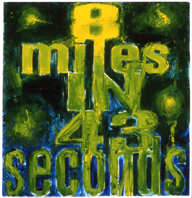
2003
Acrylic on 65 lb. acid-free cover paper
11” x 8.5”
Installation Narrative
They (airmen) practiced dropping the ‘pumpkins’* from their bomb bays and getting clear of the explosion fast. They made tight 158-degree turns and nosed their planes into shallow dives to gain getaway speed. Some of them thought the wings would rip from the fuselage. The bombers would need eight miles between them and the explosion in order to escape. They would have just forty-three seconds to make it. (Day of Trinity, Lansing Lamont, p. 88)
*These dummy bombs were actually teardrop models of the implosion weapon, bulbous up front and tapered back to the fins.
I used to commute 8 miles from my mother’s residence in Montrose, N.Y. to The Art Barn in Ossining, N.Y. (where I was employed as a custom picture framer for 22 years). To remove the moisture from a photograph before drymounting it, I put it between two sheets of brown Kraft paper and place it in the drymount press (which is a little over 26” deep and 38” wide and opens and closes like a giant clam). I apply heat (180° F) for 43 seconds, open the press, and then close the press for an additional 30 seconds. I imagined traveling from my mother’s house to work in 2 seconds less than the time it takes me to largely dehumidify a photo. I believe I’d pull up to The Art Barn without skin.
11. “XXI [12-6-2003]”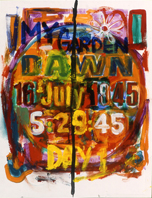
2003
Acrylic on 65 lb. acid-free cover paper
11” x 8.5”
From the Collection of Fred Gillen Jr.
Installation Narrative
A pinprick of a brilliant light punctured the darkness, spurted upward in a flaming jet, then spilled into a dazzling cloche of fire that bleached the desert to a ghastly white. It was precisely 5:29:45 a.m.
Georgia Green felt the flash and a sudden loss of breath. “What’s that?” she gasped and clutched the arm of her brother-in-law. The car shook and swerved off onto the shoulder of the road. In the floodlit control center Joe McKibben was aware of an even brighter light paling the instrument panels. Across the test site everything suddenly became infinitely tiny. Men burrowed into the sand like ants. Oppenheimer in that blinding instant thought of fragments from the sacred Hindu epic, “Bhagavad-Gita”:
If the radiance of a thousand suns
Were to burst at once into the sky,
That would be like the splendor
of the Mighty One…
I am become Death,
The shatterer of worlds.
For a fraction of a second the light in that bell-shaped fire mass was greater than any ever produced before on earth. Its intensity was such that it could have been seen from another planet. The temperature at its center was four times that at the center of the sun and more than 10,000 times that at the sun’s surface. The pressure, caving in the ground beneath, was over 100 billion atmospheres, the most ever to occur at the earth’s surface. The radioactivity emitted was equal to one million times that of the world’s total radium supply.
No living thing touched by that raging furnace survived. Within a millisecond the fireball had struck the ground, flattening out at its base and acquiring a skirt of molten black dust that boiled and billowed in all directions. Within twenty-five milliseconds the fireball had expanded to a point where the Washington Monument would have been enveloped. At eight-tenths of a second, the ball’s white-hot dome had topped the Empire State Building. The shock wave caromed across the roiling desert.
Human response may have been the same as on that first dawn in the basement of time when Man discovered fire: fright at first, giving way to impetuous curiosity, then an awed realization of the phenomenon and finally, primitive glee.
Men turned to look at the fireball, inflated now a half-mile wide, and wondered if it would ever stop growing. In their excitement, many threw off their dark glasses and instantly lost sight of what they had waited years to see. At Base Camp there were silent handclasps and murmurs of amazement; at South-10,000, a squabble of excited voices that rose to a deafening din; and on Compania Hill, a piercing whoop followed by a mad jig that suggested to one observer the fire rites of prehistoric savages. (Day of Trinity, Lansing Lamont, pp. 235-236)
12. “XXII [12-8-2003]”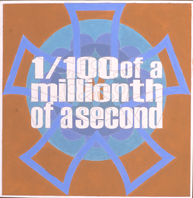
2003
Acrylic on 65 lb. acid-free cover paper
11” x 8.5”
From the Collection of Paul Quinn
Installation Narrative
By far the most important experiments were those diagnosing how the implosion assembly worked and those measuring the speed of the explosion itself. The Venetian Bruno Rossi directed this chore. His task defied comprehension. He would have to determine the velocity at which the energy of the blast multiplied in intensity. The faster it intensified, the more powerful would be the explosion. The problem was how to measurethis prodigy: It all took place within 1/100 of a millionth of a second. (Day of Trinity,Lansing Lamont, p. 105)
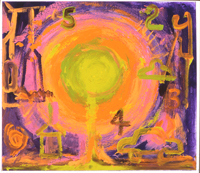 13. “XXIII [12-11-2003]”
13. “XXIII [12-11-2003]”
2003
Acrylic on 65 lb. acid-free cover paper
8.5” x 11”
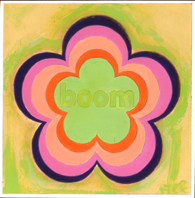 14. “boom [12-11-2003]”
14. “boom [12-11-2003]”
2003
Acrylic on 65 lb. acid-free cover paper
11” x 8.5”
From the Collection of Amy Cabot
Installation Narrative
“XXIII [12-11-203]” and “boom [12-11-2003]”
At 2,000 feet, still hurtling through the atmosphere, the seething ball turned reddish yellow, then a dull blood-red. It churned and belched forth smoking flame in an elemental fury. Below, the countryside was bathed in golden and lavender hues that lit every mountain peak and crevasse, every arroyo and bush with a clarity no artist could capture. At 15, 000 feet the fireball cleaved the overcast in a bubble of orange that shifted to a darkening pink. Now, with its flattened top, it resembled a giant mushroom trailed by a stalk of radioactive dust. Within another few seconds the fireball had reached 40, 000 feet and pancaked out in a mile-wide ring of graying ash. The air had ionized around it and crowned it with a lustrous purple halo. As the cloud finally settled, its chimney-shaped column of dust drifted northward and a violet afterglow tinged the heavens above Trinity. (Day of Trinity, Lansing Lamont, p. 239)
15. “XXV [12-15-2003], In Memory of Dr. Louis Slotin”![XXV [12-15-2003], In Memory of Dr. Louis Slotin](http://lindajeanfisher.com/images/TrinityandHBombPaintings/JPEG/XXV12-15-2003InMemoryofDrLouisSlotin.jpg)
2003
Acrylic on 65 lb. acid-free cover paper
8.5” x 11”
Installation Narrative
The following passage is from Brigitt Martin’s The Secret Life of Louis Slotin, 1910-1946:
This is how the story goes: Slotin and the others were gathered in a laboratory performing an experiment known as ‘tickling the dragon’s tail.’
The experiment involved creating the beginning of a fission reaction by bringing together two metal hemispheres of highly reactive, beryllium-coated plutonium. The trick was to bring the hemispheres close enough together without allowing them to touch. But on one fateful day—May 21, 1946—after successfully ‘tickling the dragon’s tail’ dozens of times before, the hemispheres touched, generating a vast flux of radiation.
Slotin’s reaction was to use his hands to separate the hemispheres. His body shielded the others from the neutrons that emanated from the plutonium. While the results proved fatal to him nine days later, he is credited with having saved the other seven scientists from an agonizing death.
I had first read about Dr. Slotin in the book Day of Trinity on Friday, 12 December 2003. I could not stop thinking about him. On Sunday, 14 December 2003, I spent a couple of hours on the Internet researching his life and looking at diagrams and photos depicting the event on 21 May 1946. I was beginning to get a sore throat and woke up Monday morning with the same virus my mother had just recovered from. I slept in the morning, and shortly before noon was forced out of bed by my need to paint a picture for Dr. Slotin. Out of all the stories of the people associated with the creation of the atomic bomb, Dr. Slotin’s is the one that turned me inside out.
16. “XXX [12-24-2003/12-26-2003]”
2003 Acrylic on 65 lb. acid-free cover paper
11” x 8.5”
From the Collection of Joanne Hayes
Installation Narrative
To many of them Trinity was not only a means toward ending the war. It represented the climax of an intriguing intellectual match between the scientists and the cosmos. The prospect of solving the bomb’s cosmic mysteries, of having their calculations proved correct, seemed far more fascinating and important to the scientists than the prospect of their opening an era obsessed by fear and devoted to control of those very mysteries. They were unbottling the atomic genie, but others would have to worry about its care and feeding. The scientist at Los Alamos felt they had every right to celebrate the end of a long endeavor and to toast their hopes for success at Trinity.(Day of Trinity, Lansing Lamont)
17. “XXXII [12-28-2003]”
2003
Acrylic on 65 lb. acid-free cover paper
11” x 8.5”
Installation Narrative
Major Robert Furman signed a receipt for a lead bucket that morning at Los Alamos. The bucket, slightly bigger than a large cookie can, had a handle. But Furman and his co-courier, Captain Nolan, couldn’t budge it. It contained 200 pounds of lead insulation surrounding a core of enriched uranium that represented a cool $300,000,000 investment. Shortly after eleven A.M. Furman and Nolan started out from The Hill to deliver the bucket to Tinian. (Day of Trinity, Lansing Lamont, pp. 175 and 177)
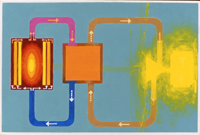
![XVII [11-30-2003]](http://lindajeanfisher.com/images/TrinityandHBombPaintings/JPEG/XVII11-30-2003.jpg)
![XVIII [12-1-2003]](http://lindajeanfisher.com/images/TrinityandHBombPaintings/JPEG/XVIII12-1-2003.jpg)